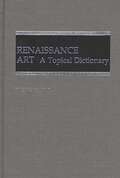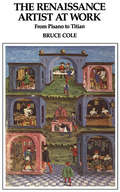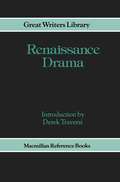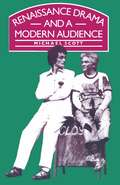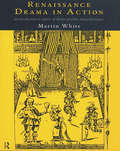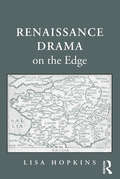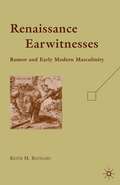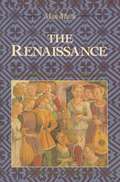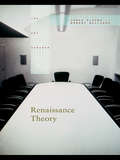- Table View
- List View
Renaissance and Baroque Art: Selected Essays (Essays by Leo Steinberg)
by Leo SteinbergLeo Steinberg was one of the most original art historians of the twentieth century, known for taking interpretive risks that challenged the profession by overturning reigning orthodoxies. In essays and lectures ranging from old masters to contemporary art, he combined scholarly erudition with an eloquent prose that illuminated his subject and a credo that privileged the visual evidence of the image over the literature written about it. His writings, sometimes provocative and controversial, remain vital and influential reading. Steinberg’s perceptions evolved from long, hard looking at his objects of study. Almost everything he wrote included passages of formal analysis, but always put into the service of interpretation. This volume begins and ends with thematic essays on two fundamental precepts of Steinberg’s art history: how dependence on textual authority mutes the visual truths of images and why artists routinely copy or adapt earlier artworks. In between are fourteen chapters on masterpieces of renaissance and baroque art, with bold and enlightening interpretations of works by Mantegna, Filippo Lippi, Pontormo, El Greco, Caravaggio, Steen and, finally, Velázquez. Four chapters are devoted to some of Velázquez’s best-known paintings, ending with the famously enigmatic Las Meninas. Renaissance and Baroque Art is the third volume in a series that presents Steinberg’s writings, selected and edited by his longtime associate Sheila Schwartz.
Renaissance and Baroque Art: Selected Essays (Essays by Leo Steinberg)
by Leo SteinbergLeo Steinberg was one of the most original art historians of the twentieth century, known for taking interpretive risks that challenged the profession by overturning reigning orthodoxies. In essays and lectures ranging from old masters to contemporary art, he combined scholarly erudition with an eloquent prose that illuminated his subject and a credo that privileged the visual evidence of the image over the literature written about it. His writings, sometimes provocative and controversial, remain vital and influential reading. Steinberg’s perceptions evolved from long, hard looking at his objects of study. Almost everything he wrote included passages of formal analysis, but always put into the service of interpretation. This volume begins and ends with thematic essays on two fundamental precepts of Steinberg’s art history: how dependence on textual authority mutes the visual truths of images and why artists routinely copy or adapt earlier artworks. In between are fourteen chapters on masterpieces of renaissance and baroque art, with bold and enlightening interpretations of works by Mantegna, Filippo Lippi, Pontormo, El Greco, Caravaggio, Steen and, finally, Velázquez. Four chapters are devoted to some of Velázquez’s best-known paintings, ending with the famously enigmatic Las Meninas. Renaissance and Baroque Art is the third volume in a series that presents Steinberg’s writings, selected and edited by his longtime associate Sheila Schwartz.
Renaissance and Baroque Art: Selected Essays (Essays by Leo Steinberg)
by Leo SteinbergLeo Steinberg was one of the most original art historians of the twentieth century, known for taking interpretive risks that challenged the profession by overturning reigning orthodoxies. In essays and lectures ranging from old masters to contemporary art, he combined scholarly erudition with an eloquent prose that illuminated his subject and a credo that privileged the visual evidence of the image over the literature written about it. His writings, sometimes provocative and controversial, remain vital and influential reading. Steinberg’s perceptions evolved from long, hard looking at his objects of study. Almost everything he wrote included passages of formal analysis, but always put into the service of interpretation. This volume begins and ends with thematic essays on two fundamental precepts of Steinberg’s art history: how dependence on textual authority mutes the visual truths of images and why artists routinely copy or adapt earlier artworks. In between are fourteen chapters on masterpieces of renaissance and baroque art, with bold and enlightening interpretations of works by Mantegna, Filippo Lippi, Pontormo, El Greco, Caravaggio, Steen and, finally, Velázquez. Four chapters are devoted to some of Velázquez’s best-known paintings, ending with the famously enigmatic Las Meninas. Renaissance and Baroque Art is the third volume in a series that presents Steinberg’s writings, selected and edited by his longtime associate Sheila Schwartz.
Renaissance And Renascences In Western Art
by Erwin PanofskyRenaissance and Renascences in Western Art spans the period from the 10th to the 15th century, including discussion of the Carolingian renaissance and the 12th century proto-renaissance. Erwin Panofsky posits that there were "reanscences" prior to the widely known Renaissance that began in Italy in the 14th century. Whereas earlier renascences can be classified as revivals, the Renaissance was a unique instance that led to a wider cultural transformation.
Renaissance And Renascences In Western Art
by Erwin PanofskyRenaissance and Renascences in Western Art spans the period from the 10th to the 15th century, including discussion of the Carolingian renaissance and the 12th century proto-renaissance. Erwin Panofsky posits that there were "reanscences" prior to the widely known Renaissance that began in Italy in the 14th century. Whereas earlier renascences can be classified as revivals, the Renaissance was a unique instance that led to a wider cultural transformation.
Renaissance Art: A Topical Dictionary
by Irene EarlsThis dictionary is a quick and useful reference source for identifying and understanding the Renaissance art of Italy and northern Europe. Arranged in alphabetical sequence, the more than eight hundred entries provide basic information about topics that were common subjects in painting, sculpture, and decorative arts of the period. Additionally, entries on characteristic schools, techniques, media, and other terminology have been included as background information as well as to provide an art history vocabulary necessary for comprehending or clarifying certain topics. Supplemental information on various related topics is cross-referenced for easy access, and the reader is provided with an even more complete location of topics and other entries with see references and a subject index. As an aid to further study, a list of northern and Italian Renaissance artists, which includes life dates and nationalities, has been included. A bibliography is also provided for further reference.
Renaissance Art in Venice: From Tradition to Individualism (Renaissance Art)
by Tom NicholsThis book examines how sustainability has the potential to transform both the fashion system and the innovators who work within it.Sustainability is arguably the defining theme of the twenty-first century. The issues in fashion are broad-ranging and include labour abuses, toxic chemicals use and conspicuous consumption, giving rise to an undeniable tension between fashion and sustainability. The book is organized in three parts. The first part is concerned with transforming fashion products across the garment's lifecycle and includes innovation in materials, manufacture, distribution, use and re-use. The second part looks at ideas that are transforming the fashion system at root into something more sustainable, including new business models that reduce material throughput. The third section is concerned with transforming the role of fashion designers and looks to examples where the designer changes from a stylist or creator into a communicator, activist or facilitator.
The Renaissance Artist At Work: From Pisano To Titian
by Bruce ColeThis book gives the necessary background for the study and appreciation of Italian painting and sculpture from about 1250 to 1550. It tells how the artists learned their craft, the organization of their workshops, and the guilds they belonged to; how their customers or patrons treated them and where their work was displayed?churches, civic buildings, or private homes. The book discusses how art was made?tempera, oil, panel, canvas, fresco; it surveys the characteristic types of Renaissance art?altarpieces, portraits, tombs, busts, doors fountains, medals, etc.
The Renaissance Artist At Work: From Pisano To Titian (Icon Editions Ser.)
by Bruce ColeThis book gives the necessary background for the study and appreciation of Italian painting and sculpture from about 1250 to 1550. It tells how the artists learned their craft, the organization of their workshops, and the guilds they belonged to; how their customers or patrons treated them and where their work was displayed?churches, civic buildings, or private homes. The book discusses how art was made?tempera, oil, panel, canvas, fresco; it surveys the characteristic types of Renaissance art?altarpieces, portraits, tombs, busts, doors fountains, medals, etc.
Renaissance Drama in Action
by Martin WhiteRenaissance Drama in Action is a fascinating exploration of Renaissance theatre practice and staging. Covering questions of contemporary playhouse design, verse and language, staging and rehearsal practices, and acting styles, Martin White relates the characteristics of Renaissance theatre to the issues involved in staging the plays today. This refreshingly accessible volume: * examines the history of the plays on the English stage from the seventeenth century to the present day * explores questions arising from reconstructions, with particular reference to the new Globe Theatre * includes interviews with, and draws on the work and experience of modern theatre practitioners including Harriet Walter, Matthew Warchus, Trevor Nunn, Stephen Jeffreys, Adrian Noble and Helen Mirren * includes discussions of familiar plays such as The Duchess of Malfi and 'Tis Pity She's A Whore, as well as many lesser known play-texts Renaissance Drama in Action offers undergraduates and A-level students an invaluable guide to the characteristics of Elizabethan and Jacobean drama, and its relationship to contemporary theatre and staging.
Renaissance Drama in Action: An Introduction To Aspects Of Theatre Practice And Performance
by Martin WhiteRenaissance Drama in Action is a fascinating exploration of Renaissance theatre practice and staging. Covering questions of contemporary playhouse design, verse and language, staging and rehearsal practices, and acting styles, Martin White relates the characteristics of Renaissance theatre to the issues involved in staging the plays today. This refreshingly accessible volume: * examines the history of the plays on the English stage from the seventeenth century to the present day * explores questions arising from reconstructions, with particular reference to the new Globe Theatre * includes interviews with, and draws on the work and experience of modern theatre practitioners including Harriet Walter, Matthew Warchus, Trevor Nunn, Stephen Jeffreys, Adrian Noble and Helen Mirren * includes discussions of familiar plays such as The Duchess of Malfi and 'Tis Pity She's A Whore, as well as many lesser known play-texts Renaissance Drama in Action offers undergraduates and A-level students an invaluable guide to the characteristics of Elizabethan and Jacobean drama, and its relationship to contemporary theatre and staging.
Renaissance Drama on the Edge
by Lisa HopkinsRecurring to the governing idea of her 2005 study Shakespeare on the Edge, Lisa Hopkins expands the parameters of her investigation beyond England to include the Continent, and beyond Shakespeare to include a number of dramatists ranging from Christopher Marlowe to John Ford. Hopkins also expands her notion of liminality to explore not only geographical borders, but also the intersection of the material and the spiritual more generally, tracing the contours of the edge which each inhabits. Making a journey of its own by starting from the most literally liminal of physical structures, walls, and ending with the wholly invisible and intangible, the idea of the divine, this book plots the many and various ways in which, for the Renaissance imagination, metaphysical overtones accrued to the physically liminal.
Renaissance Drama on the Edge
by Lisa HopkinsRecurring to the governing idea of her 2005 study Shakespeare on the Edge, Lisa Hopkins expands the parameters of her investigation beyond England to include the Continent, and beyond Shakespeare to include a number of dramatists ranging from Christopher Marlowe to John Ford. Hopkins also expands her notion of liminality to explore not only geographical borders, but also the intersection of the material and the spiritual more generally, tracing the contours of the edge which each inhabits. Making a journey of its own by starting from the most literally liminal of physical structures, walls, and ending with the wholly invisible and intangible, the idea of the divine, this book plots the many and various ways in which, for the Renaissance imagination, metaphysical overtones accrued to the physically liminal.
Renaissance Earwitnesses: Rumor and Early Modern Masculinity
by K. BotelhoRenaissance Earwitnesses examines how maintaining masculinity on the early modern stage is intimately tied to 'earwitnessing,' or a sense of 'judicious listening' in his reading of plays by Marlowe, Shakespeare, Cary, and Jonson.
Renaissance in the Classroom: Arts Integration and Meaningful Learning
by Gail E. Burnaford Arnold Aprill Cynthia WeissThis book invites readers to consider the possibilities for learning and growth when artists and arts educators come into a classroom and work with teachers to engage students in drama, dance, visual art, music, and media arts. It is a nuts-and-bolts guide to arts integration, across the curriculum in grades K-12, describing how students, teachers, and artists get started with arts integration, work through classroom curriculum involving the arts, and go beyond the typical "unit" to engage in the arts throughout the school year. The framework is based on six years of arts integration in the Chicago Arts Partnerships in Education (CAPE). Renaissance in the Classroom: *fully explains the planning, implementation, and assessment processes in arts integration; *frames arts integration in the larger context of curriculum integration, problem-based learning, and the multiple intelligences; *provides the theoretical frameworks that connect standards-based instruction to innovative teaching and learning, and embeds arts education in the larger issue of whole school improvement; *blends a description of the arts integration process with personal stories, anecdotes, and impressions of those involved, with a wealth of examples from diverse cultural backgrounds; *tells the stories of arts integration from the classroom to the school level and introduces the dynamics of arts partnerships in communities that connect arts organizations, schools, and neighborhoods; *offers a variety of resources for engaging the arts--either as an individual teacher or within a partnership; and *includes a color insert that illustrates the work teachers, students, and artists have done in arts integration schools and an extensive appendix of tools, instruments, Web site, contacts, and curriculum ideas for immediate use. Of primary interest to K-12 classroom teachers, arts specialists, and visiting artists who work with young people in schools or community arts organizations, this book is also highly relevant and useful for policymakers, arts partnerships, administrators, and parents.
Renaissance in the Classroom: Arts Integration and Meaningful Learning
by Gail Burnaford Arnold Aprill Cynthia WeissThis book invites readers to consider the possibilities for learning and growth when artists and arts educators come into a classroom and work with teachers to engage students in drama, dance, visual art, music, and media arts. It is a nuts-and-bolts guide to arts integration, across the curriculum in grades K-12, describing how students, teachers, and artists get started with arts integration, work through classroom curriculum involving the arts, and go beyond the typical "unit" to engage in the arts throughout the school year. The framework is based on six years of arts integration in the Chicago Arts Partnerships in Education (CAPE). Renaissance in the Classroom: *fully explains the planning, implementation, and assessment processes in arts integration; *frames arts integration in the larger context of curriculum integration, problem-based learning, and the multiple intelligences; *provides the theoretical frameworks that connect standards-based instruction to innovative teaching and learning, and embeds arts education in the larger issue of whole school improvement; *blends a description of the arts integration process with personal stories, anecdotes, and impressions of those involved, with a wealth of examples from diverse cultural backgrounds; *tells the stories of arts integration from the classroom to the school level and introduces the dynamics of arts partnerships in communities that connect arts organizations, schools, and neighborhoods; *offers a variety of resources for engaging the arts--either as an individual teacher or within a partnership; and *includes a color insert that illustrates the work teachers, students, and artists have done in arts integration schools and an extensive appendix of tools, instruments, Web site, contacts, and curriculum ideas for immediate use. Of primary interest to K-12 classroom teachers, arts specialists, and visiting artists who work with young people in schools or community arts organizations, this book is also highly relevant and useful for policymakers, arts partnerships, administrators, and parents.
The Renaissance: From The 1470s To The End Of The 16th Century (Man And Music Ser.)
by Iain FenlonFrom the series examining the development of music in specific places during particular times, this book looks at European countries at the time of the Renaissance, concentrating on Italy. It is to be published in conjunction with a television series.
Renaissance Perspectives in Literature and the Visual Arts
by Murray RostonRoston demonstrates that what emerges is not a fixed or monolithic pattern for each generation but a dynamic series of responses to shared challenges. The book relates leading English writers and literary modes to contemporary developments in architecture, painting, and sculpture, exploring by a close reading of the texts and the artistic works the insights such comparison offers.Originally published in 1987.The Princeton Legacy Library uses the latest print-on-demand technology to again make available previously out-of-print books from the distinguished backlist of Princeton University Press. These editions preserve the original texts of these important books while presenting them in durable paperback and hardcover editions. The goal of the Princeton Legacy Library is to vastly increase access to the rich scholarly heritage found in the thousands of books published by Princeton University Press since its founding in 1905.
Renaissance Porticoes and Painted Pergolas: Nature and Culture in Early Modern Italy (Visual Culture in Early Modernity)
by Natsumi NonakaThis book is the first study of the portico and its decorative program as a cultural phenomenon in Renaissance Italy. Focusing on a largely neglected group of porticoes decorated with painted pergolas that appeared in Rome and environs in the sixteenth and early seventeenth centuries, it tells the story of how an element of the garden—the pergola—became a pictorial topos in portico decoration, and evolved, hand in hand with its real cousin in the garden, into an object for cultural emulation among the educated patrons of early modern Rome. The liminality of both the portico and the pergola at the interface of architecture and garden is key to the interpretation of these architectural and painted forms, which rests on the intersecting frameworks of the classical tradition, natural history, and the cultural identity of the aristocracy. In the mediating space of the Renaissance portico, the illusionism pergola created an art gallery, a natural history museum, and a virtual garden where one could engage in leisurely strolls, learned conversations, appreciation of art, and scientific investigation, as well as extensive travel across time and space. The book proposes the interpretation that the illusionistic pergola was an artistic formula for the early modern perception of nature.
Renaissance Porticoes and Painted Pergolas: Nature and Culture in Early Modern Italy (Visual Culture in Early Modernity)
by Natsumi NonakaThis book is the first study of the portico and its decorative program as a cultural phenomenon in Renaissance Italy. Focusing on a largely neglected group of porticoes decorated with painted pergolas that appeared in Rome and environs in the sixteenth and early seventeenth centuries, it tells the story of how an element of the garden—the pergola—became a pictorial topos in portico decoration, and evolved, hand in hand with its real cousin in the garden, into an object for cultural emulation among the educated patrons of early modern Rome. The liminality of both the portico and the pergola at the interface of architecture and garden is key to the interpretation of these architectural and painted forms, which rests on the intersecting frameworks of the classical tradition, natural history, and the cultural identity of the aristocracy. In the mediating space of the Renaissance portico, the illusionism pergola created an art gallery, a natural history museum, and a virtual garden where one could engage in leisurely strolls, learned conversations, appreciation of art, and scientific investigation, as well as extensive travel across time and space. The book proposes the interpretation that the illusionistic pergola was an artistic formula for the early modern perception of nature.
Renaissance Theories of Vision
by John Shannon Hendrix Charles H. CarmanHow are processes of vision, perception, and sensation conceived in the Renaissance? How are those conceptions made manifest in the arts? The essays in this volume address these and similar questions to establish important theoretical and philosophical bases for artistic production in the Renaissance and beyond. The essays also attend to the views of historically significant writers from the ancient classical period to the eighteenth century, including Plato, Aristotle, Plotinus, St Augustine, Ibn Sina (Avicenna), Ibn al-Haytham (Alhazen), Ibn Sahl, Marsilio Ficino, Nicholas of Cusa, Leon Battista Alberti, Gian Paolo Lomazzo, Gregorio Comanini, John Davies, Rene Descartes, Samuel van Hoogstraten, and George Berkeley. Contributors carefully scrutinize and illustrate the effect of changing and evolving ideas of intellectual and physical vision on artistic practice in Florence, Rome, Venice, England, Austria, and the Netherlands. The artists whose work and practices are discussed include Fra Angelico, Donatello, Leonardo da Vinci, Filippino Lippi, Giovanni Bellini, Raphael, Parmigianino, Titian, Bronzino, Johannes Gumpp and Rembrandt van Rijn. Taken together, the essays provide the reader with a fresh perspective on the intellectual confluence between art, science, philosophy, and literature across Renaissance Europe.
Renaissance Theories of Vision
by John Shannon Hendrix Charles H. CarmanHow are processes of vision, perception, and sensation conceived in the Renaissance? How are those conceptions made manifest in the arts? The essays in this volume address these and similar questions to establish important theoretical and philosophical bases for artistic production in the Renaissance and beyond. The essays also attend to the views of historically significant writers from the ancient classical period to the eighteenth century, including Plato, Aristotle, Plotinus, St Augustine, Ibn Sina (Avicenna), Ibn al-Haytham (Alhazen), Ibn Sahl, Marsilio Ficino, Nicholas of Cusa, Leon Battista Alberti, Gian Paolo Lomazzo, Gregorio Comanini, John Davies, Rene Descartes, Samuel van Hoogstraten, and George Berkeley. Contributors carefully scrutinize and illustrate the effect of changing and evolving ideas of intellectual and physical vision on artistic practice in Florence, Rome, Venice, England, Austria, and the Netherlands. The artists whose work and practices are discussed include Fra Angelico, Donatello, Leonardo da Vinci, Filippino Lippi, Giovanni Bellini, Raphael, Parmigianino, Titian, Bronzino, Johannes Gumpp and Rembrandt van Rijn. Taken together, the essays provide the reader with a fresh perspective on the intellectual confluence between art, science, philosophy, and literature across Renaissance Europe.
Renaissance Theory (The Art Seminar)
by James Elkins Robert WilliamsRenaissance Theory presents an animated conversation among art historians about the optimal ways of conceptualizing Renaissance art, and the links between Renaissance art and contemporary art and theory. This is the first discussion of its kind, involving not only questions within Renaissance scholarship, but issues of concern to art historians and critics in all fields. Organized as a virtual roundtable discussion, the contributors discuss rifts and disagreements about how to understand the Renaissance and debate the principal texts and authors of the last thirty years who have sought to reconceptualize the period. They then turn to the issue of the relation between modern art and the Renaissance: Why do modern art historians and critics so seldom refer to the Renaissance? Is the Renaissance our indispensable heritage, or are we cut off from it by the revolution of modernism? The volume includes an introduction by Rebecca Zorach and two final, synoptic essays, as well as contributions from some of the most prominent thinkers on Renaissance art including Stephen Campbell, Michael Cole, Frederika Jakobs, Claire Farago, and Matt Kavaler.


